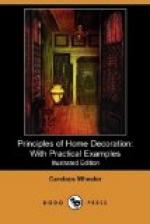Yet I know one instance of a library where a genuine old foliage tapestry has been cut and fitted to the walls and between bookcases and doors, where the wood of the room is in mahogany, and a great chimney-piece of Caen stone of Richardson’s designing fills nearly one side of the room. Of course the tapestry is unapproachable in effect in this particular place and with its surroundings. It has the richness and softness of velvet, and the red of the mahogany doors and furniture finds exactly its foil in the blue greens and soft browns of the web, while the polished floor and velvety antique rugs bring all the richness of the walls down to one’s feet and to the hearth with its glow of fire. But this particular room hardly makes an example for general following. It is really a house of state, a house without children, one in which public life predominates.
There is a very flagrant far-away imitation of tapestry which is so far from being good that it is a wonder it has had even a moderate success, imitation which does not even attempt the decorative effect of the genuine, but substitutes upon an admirably woven cotton or woollen canvas, figure panels, copied from modern French masters, and suggestive of nothing but bad art. Yet these panels are sometimes used (and in fact are produced for the purpose of being used) precisely as a genuine tapestry would be, although the very fact of pretence in them, brings a feeling of untruth, quite at variance with the principles of all good art. The objection to pictures transferred to tapestries holds good, even when the tapestries are genuine.
The great cartoons of Raphael, still to be seen in the Kensington Museum, which were drawn and coloured for Flemish weavers to copy, show a perfect adaptation to the medium of weaving, while the paintings in the Vatican by the same great master are entirely inappropriate to textile reproduction.
A picture cannot be transposed to different substance and purpose without losing the qualities which make it valuable. The double effort to be both a tapestry and a picture is futile, and brings into disrepute a simple art of imitation which might become respectable if its capabilities were rightly used.
No one familiar with collections of tapestries can fail to recognise the largeness and simplicity of treatment peculiar to tapestry subjects as contrasted with the elaboration of pictures.
If we grant that in this modern world of hurry, imitation of tapestries is legitimate, the important question is, what are the best subjects, and what is the best use for such imitations?
The best use is undoubtedly that of wall-covering; and that was, indeed, the earliest object for which they were created. They were woven to cover great empty spaces of unsightly masonry; and they are still infinitely useful and beautiful in grand apartments whose barren spaces are too large for modern pictures, and which need the disguise of a suggestion of scenery or pictorial subject.




